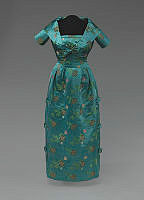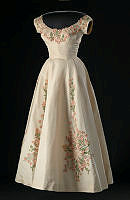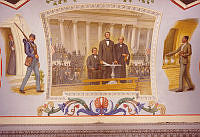Slavery, Freedom, and the Struggle to Keep a Family Together
Copyright © January 31, 2019 White House Historical Association. All rights reserved under international copyright conventions. No part of this article may be reproduced or utilized in any form or by any means, electronic or mechanical, including photocopying, recording, or by any information storage and retrieval system, without permission in writing from the publisher. Requests for reprint permissions should be addressed to books@whha.org
This article is part of the Slavery in the President’s Neighborhood initiative. Explore the Timeline
Although President Thomas Jefferson owned hundreds of enslaved men, women, and children in his lifetime, he brought only a handful with him to the White House. In need of additional help, he hired the labor of an enslaved man named John Freeman from Dr. William Baker, the Maryland physician who owned him. The practice of hiring out enslaved workers in exchange for a wage paid to their owner was quite common, especially in urban areas. In fact, hiring transactions happened much more frequently than sales, and most enslaved individuals in the South would be contracted out to work for someone who did not own them at least once during their lifetimes.1 While hiring could occur by the month, week, or even day, the typical term was a year, often ranging from January 1st to December 25th. The practice was so common that, according to one formerly enslaved woman, “New Year’s Day was always called Hiring Day by the slaves.”2 Click here to learn more about the enslaved households of President Thomas Jefferson.

Advertisements like these were frequently placed in newspapers during the nineteenth century, and typically specified the social status of the worker desired, along with the skills or training required.
The Evening Star (Washington, D.C.), Library of CongressFor a sum of $8 per month, paid to Dr. Baker, John Freeman was sent to work in President Jefferson’s White House.3 His duties included waiting at the dining table, taking care of the hall and dining room, and possibly attending to the president personally, although Jefferson generally avoided having a manservant. Freeman quickly became one of the president’s favorites and routinely accompanied him on his trips back to Monticello.4
Jonathan D. Martin argues in his work on slavery in the American South that because hiring essentially introduced a secondary owner into the system of slavery, it opened up new opportunities for enslaved people “to shape their work and family lives, to bring white people into conflict with each other, and to destabilize the system that trapped them.”5 Freeman adopted some of these tactics during the period in which he was hired out, because despite the legal constraints of his enslaved status, he learned to negotiate his labor with President Jefferson.
During a trip back to Monticello in 1803, Freeman fell in love with Melinda Colbert, an enslaved woman in the household of Jefferson’s daughter, Maria Eppes, and expressed his desire to marry her. When Mrs. Eppes died in 1804, Freeman feared that Melinda would be sold and they would be separated forever. He wrote a letter to Jefferson imploring him to “be so good as to keep us both,” that is, to purchase both John and Melinda. He couched the request in self-deprecating language, writing that “I have been foolish enofe to ingage myself to Melinda,” perhaps hoping that blaming himself would prevent the president from reading his request as presumptuous or demanding.6 Jefferson agreed to purchase John Freeman from Dr. Baker, who stipulated in the contract that John was to be given his freedom in 1815. However, he declined to purchase Melinda, claiming that there were already too many servants “in idleness” at Monticello and that for the White House, he preferred “white servants, who when they misbehave can be exchanged.”7 Luckily for the Freemans, Melinda was ultimately hired out near Monticello and they were able to marry after all.8

John Freeman to Thomas Jefferson, March 2, 1809, The Thomas Jefferson Papers at the Library of Congress, Manuscript Division
Library of Congress, Manuscript DivisionWhen President Jefferson’s term ended in 1809, the possibility of separation resurfaced. Sometime in the previous few years, Melinda had been given her freedom, and had come to work at the White House as a hired servant. Under an 1806 law, freed slaves had to leave Virginia within one year after being granted their freedom. Failure to do so would result in either punishment or re-enslavement. The law was designed to make it harder for free African Americans and to reduce the state’s population of free black people.9 Especially after Gabriel’s Rebellion in 1800, planters and slave owners felt that free African Americans were a dangerous influence on enslaved communities and might incite revolt, so they had to be moved out of Virginia.10
If John Freeman went back to Monticello with Jefferson at the end of his term, as he was expected to do, it would have been unsafe for his free wife and their children to accompany him because of this law. In order to keep his family together, he penned another letter, but this time he did not ask outright for what he wanted. Instead, he played on Jefferson’s sense of duty as a family man. “As you wish me to go with you rather than disples [displease] you i will go and do the best i can…I shall be oblige to leave [Melinda] and the children,” he wrote. He also mentioned that “Mr Eppes says that there is such a law,” suggesting that it was Jefferson’s widower son-in-law, John Wayles Eppes, who warned the Freemans of the legal dangers facing their family.11 Invoking Eppes’ name might have been a way to imply that the Freemans had a sympathetic supporter – after all, it was probably Eppes who had freed Melinda. It might also have reminded Jefferson of his own family ties and how painful family separation could be.

2nd Lieutenant John Freeman Shorter of the 55th Massachusetts Volunteer Infantry. He was one of only three commissioned officers in the regiment.
Burt Green Wilder Papers, #14-26-95. Division of Rare and Manuscript Collections, Cornell University LibraryFreeman’s emotional plea evidently worked. Jefferson agreed to sell him to the incoming president, James Madison, so that he could remain in Washington with his family. With his typical precision, Jefferson calculated out the value of the six years remaining on Freeman’s contract, a total of $231.81.12 President Madison freed Freeman in 1815 according to the terms of the contract originally set out by Dr. Baker but continued to employ him as a dining room servant until the end of his presidency. Freeman then went on to work as a waiter at Gadsby’s National Hotel and as a messenger for the State Department, and he and his wife became active in the antislavery work of Washington’s free black community.13 By the time he died in 1839, the couple had raised eight children and purchased a home on K Street NW, several blocks from the White House.14 Click here to learn more about the enslaved households of President James Madison.
Although neither John nor Melinda lived to see slavery’s demise in the United States, the Freeman family played a role in the war that ended the institution. John and Melinda’s grandson John Freeman Shorter enlisted in the 55th Massachusetts Volunteer Infantry, one of the first black regiments organized in the Union Army, in 1863. As a 2nd Lieutenant, he was one of only three commissioned black officers in the regiment.15 Shorter’s service helped ensure that families like his would no longer have to negotiate or rely on the sympathy of others in order to stay together.










